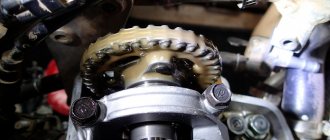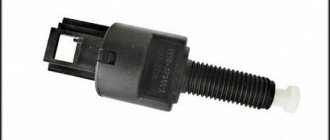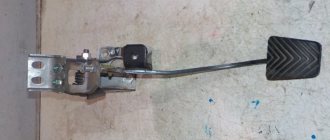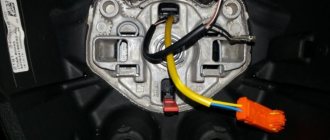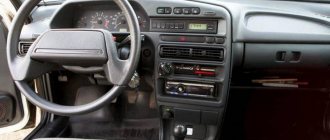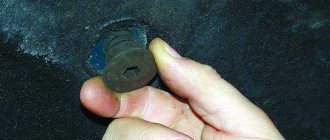VAZ 2114 water under the rugs after rain where it can leak"
.Water in the interior of a VAZ 2114.
Similar articles
15 comments on “Water in the interior of the VAZ 2114. VAZ 2114 water under the rugs after rain where it can leak” ”
Look at the rubber seal on the windshield
In the lower corner of the windshield
Are you sure the water is not antifreeze?
under which ones exactly
Replace with a new windshield seal. I had the same problem. The rubber is drying.
Carpet, felt, you lift up rubber plugs in the floor and it runs through them, you take it, change it and coat it with sealant, and everything is luxury :)
Through the windshield it’s the same for me...
Denis, if there is antifreeze then the pump has failed.
I also have a welded casing on the heater motor under the hood, I had the whole one broken, also all the water flowed into the interior when it rained, but I installed a new one and tightened it well, no more problems) the previous owner smeared all the rubber with glue and it didn’t help him at all))))
Look at the place where the fuse block is located. There is a metal connection on the side of the wing and coat it with automotive plasticine. It dried out or fell out. I had this myself. I suffered for a month; the carpet was all rotted, okay, at least the metal was fine. I covered it with sealant. Now it’s as dry as ever. desert. Look, it’s pouring a hundred pounds from there. It’s advisable for two people to do this, one from the bottle pours some water and the second watches. Pull the carpet out more
There's a hood cable running right next to it.
I used a small round file to make more drainage and everything stopped leaking.
Drainage on seal
I always had damp under the carpet on the passenger side. I got through everything, including the fuse box, the windshield, and near the right glass where the corrugation with wires enters the cabin. in the end it turned out that water flowed through the central drainage hole (which is near the heater motor casing) onto the metal protective plate of the steering rack, and from this plate the water flowed directly onto the heater hoses that enter the cabin. One hose did not have a seal, and it turned out that the hole in the body was larger than the diameter of the hose. That's where the hose began to leak. I advise you to pull out the carpet, Shumka and all the other rags that are lying there from the interior, pour water from a hose or a bucket onto the front of the car, and if the leak is good, you will immediately see where the drops are coming from on the metal. I found it like this
There are plugs in the floor. Was. Well, once again, it’s true that during a heavy downpour, a drop of water dripped onto my face from the hole through which the wires from the motor go into the cabin.
1200 rub. for the photo report
We pay for photo reports on car repairs. Earnings from 10,000 rubles/month.
Write:
The rainy season always brings some new surprises to car owners. Either “triple”, or poor starting, and for some it’s even more original, such as water under the rug. What a surprise for the driver when, upon opening the car doors, he discovers a puddle of water either on the driver’s side or on the passenger’s side. The question immediately arises: where did the water come from?
It would be nice if there was some kind of rusty trough, then there would be at least some considerations, but it looks like it’s not old, but there’s a flood. Just to solve such issues, I will cite the main weak points and holes through which water leaks, by how to visually determine the influx of water it will not be possible at all... The problem seems to be general and applies not only to domestically produced cars, but also to foreign cars. The rug also often catches me.
Where does water come from?
Water can be poured through the stove air intake (depending on the model, it appears both on the left and on the right side of the tunnel at the feet). In such a situation, you need to clean the drain holes in the engine compartment, and then coat the joint of the body and the air duct with sealant . If the liquid is from the side of the stove, then first of all it is worth checking whether it is antifreeze (the faucet often leaks simply through clamps and pipes or the heater radiator). The heater can also leak through the engine.
This is where water can flow into the Hyundai Accent
It is possible that water may leak through the gasket in the mounting block and fuse box. Also, in domestic cars, liquid leakage through the windshield frame can occur ( water leaks in the corners ). This situation can arise for several reasons:
- First, the drain holes may be clogged (they need cleaning).
- Secondly, the seal may not adhere tightly to the glass (due to drying out or cracking).
- Thirdly, perhaps the formation of a gap between the glass and the body.
It is not uncommon for water to seep through rubber door seals (torn, shriveled rubber) that need to be replaced. How simple would it be? But a lot also depends on the installation of the seal; it happens that it was simply installed incorrectly, here you need to be extremely careful. Or because the doors have sagged or are not adjusted correctly. This results in water pouring in through the doorways. In rare cases, water gets into the steering rack or cables from the driver's side.
The entire list of leak locations in Samara. I found information on the D2 forum from Andronchik67. Respect and respect to him)) A post for those who are faced with this problem and are looking for a solution to the problem. In Samara, liquid can enter the cabin in the following ways. Before reading further, check to see if the reason for the appearance of water in the cabin is simple condensation. All of the following assumes that there is enough water in the cabin for small-scale fish farming. Water in the front part (up to the feet of the rear passengers) Front window seal (usually water enters from the lower corners of the glass): • if the glass seal has become hard; • the glass seal has ruptures; • drainage holes in the glass seal and windshield frame are clogged - 2 pcs. at a distance of about 5-7 cm from the lower corners of the seal; • the side of the windshield frame in the area of the drainage holes has rotted; • the frame under the glass seal has rotted; • the glass has incorrect geometric dimensions; • just such a seal. I had to deal with the last reason after replacing the windshield seal. For a couple of months after replacing the seal, there was no water in the cabin. With the beginning of autumn, after each rain we had to remove the plugs from the floor and drain the water. The location of the leak could not be found. I drove it with ice in the cabin all winter. And only in the spring, after removing the torpedo and dancing with a tambourine for two hours, I found the location of the leak - at a distance of 6 cm from the lower corner of the glass. I had to change the seal again. Everything is fine now. At the service station they said that 9 out of 10 Samaras leak in this place. Nobody knows the reason. Heater, motor shield: • the joint “stove body - motor shield” is not coated with non-hardening sealant; • two self-tapping screws of the water-reflective casing of the stove are not seated on the sealant; • “floods” the stove when the drainage holes in the swamp are clogged; • the fan casing seal is missing, torn, “stubby” or has incorrect dimensions; • rubber plugs in the motor shield (coat the wires passing through the motor shield with non-hardening sealant); • rotted or torn out studs in the engine shield; • necessarily d.b. a rubber valve is installed in the drainage hole to the left of the ball, otherwise water gets onto the speedometer cable plug and further into the cabin. Holes in the floor: • there are no rubber plugs in the bottom; • torn covers of the gearshift lever and handbrake cable; • rotten or torn out studs for securing the converter casing; • hidden “threshold-hump” holes - when driving through deep puddles; • holes in the upper part of the sill and under the trim of the rear seat sidewalls on the VAZ-2108 when driving through deep puddles. Antifreeze: • heater tap — throw it out and replace it with two pipes (I did this and don’t regret it); • heater radiator; • clamps and pipes in the passenger compartment (install NORMA clamps and tighten “hot” with a 7 wrench). Water from the rear window washer pipe. The rear window washer tube (for hatchbacks) runs in the upper right corner of the dashboard, through the engine shield and inside the right pillar up to the ceiling, inside the right roof side member. To get to it you need to (under the dashboard) either “bend” the right side of the dashboard or lie on your back at the front passenger’s feet and bend the sound insulation. It is advisable to remove the roof lining. If it is left in a “hanging” position, it can break in the middle: the line connecting the middle fastenings of the handrails is the most flimsy place. Doors: • tightness of the door, integrity and elasticity of the seal; • wires for antennas, taxi lights, etc. passing through the door seal; • drainage holes in the door; • presence of “aprons” inside the door; • integrity and softness of velvet glass; • fastenings of side rear-view mirrors; • close windows and doors in rain and snow. Body corrosion: • windshield frame; • thresholds; • internal arches of the front wheels; • if there are no front lockers, there are no wire plugs to the signal repeaters; • floor, etc. Lack of rubber mats on the floor and holes in the standard carpet - it runs off your feet. CHY - remove and place its seal on the sealant. Rubber seal for hood cable. If the back of the car is lifted, then look at the condition of all kinds of plugs, holes, parts, etc., etc. in the rear of the car. Sunroof, antenna, flashing light in the roof... Water in the rear (from the rear passengers' feet to the rear lights) Body corrosion can lead to water in the cabin! • the presence of containers with liquids in the trunk - check the lids! • rear light seal - place on sealant (adhesive-sealant). I used BODY 920. I recently saw a seal from Audi. It is a black soft sausage about half a meter long. Non-budget price - 190 rubles. Most likely a non-curing sealant. If the gap is large, then IMHO you can use a non-hardening sealant like BODY 999. On older machines, remove the seal, clean it and turn it over to the other side; • holes for license plate; • hole for securing the separator and a small hole under it (most likely for the trim in luxury models; • rubber in the floor of the spare tire; • rubber window seals (especially pay attention to the rear window - lower corners); • clogged drains in the rear door ( for hatchbacks) - periodically clean and additionally drill 4-5 holes with a diameter of 4-4.5 mm; • rubber door seal - replace with a new one and/or adjust the door for a tight fit. It is good to use a piece of thick paper 3-4 cm wide and long 20-25 cm. Place the sheet on the seal, close the door and pull out the sheet. • rubber plugs inside the wings - 2 pcs. Sometimes they fly out, sometimes they don’t. If the lockers at the back do not have “shelves,” then dirt and water get inside the wings through the holes. • through the self-tapping screws of the lockers, when they are screwed through “through the rear arches into the passenger compartment”; • holes in the floor from the “luxury” trim; • 6 or 8 holes in the trunk along the rear side members - only rubber plugs or sealing with something will help; • hatch to the gas tank sensor - secure the hatch correctly, new rubber, sealant...; • 8 holes (4 on each side) in the feet of the rear passengers. From the factory: the bottom is filled with plastisol, the top is filled with bitumen sheet. Relevant for older cars. Install plugs.
Engine compartment
Open the hood. In the niche where the windshield wiper motor is located, there is a large hole on the side. Passes through the engine shield. It is connected to a pipe that exits above the vacuum brake booster. In some models, its location may differ slightly, but not dramatically.
This cavity typically collects leaves and debris. It is advisable to clean it so that moisture does not accumulate there. Water will flow freely through the drain hole out into the engine compartment.
In addition, in the corners of the junction of the wing and the windshield pillar there are small holes on both sides. They are designed to drain water from under the hood and the flat area of the fender. Moisture leaks out in the space between the front wheel mudguard and the fender. If this distance becomes clogged with dirt, then the lower part of the wing begins to rot, the water has nowhere to drain, and it stagnates there.
When water gets under the passenger mat of a VAZ
If moisture appears in the car interior, then the driver has no peace of mind until he figures out what’s wrong and fixes the leak. Most often, such a nuisance happens after rain. The most common cause is a windshield that is not sealed properly, which allows raindrops to enter the cabin.
It happens that you have to disassemble the door in order to make sure that the plastic screens, whose function is to close the technological windows, are in order. You can check the windshield by having someone spray it while watching from below what is happening.
The following can happen if the channels are clogged: the water flow will split, one part will go to the driver's side, the other to the passenger's seat. Then, under the hood, the water will go into the drain hole, and through the body it will begin to flow to the stove pipes.
But in VAZ 2114, 2107, water can accumulate on the floor if the rubber seals, which are located on the inside along the perimeter of the door, are worn out. Worn seals, which now do not fit tightly, can be identified immediately - the rubber becomes torn and shrunken.
So it's time to replace them. In this case, professionals advise installing double seals, so before disassembling half the machine in search of the cause, you need to check if there are any cracks that allow moisture to pass through. During assembly, they can also make a mistake and install them incorrectly, therefore, even if the car is completely new and water appears in the cabin, the seals should be checked first. The main thing is that the glass and the body are one.
How to replace the pump on a VAZ 2114 yourself
The water pump of the engine cooling system, or simply the pump, is the most important element that is responsible for pumping coolant through the channels of the cooling system. Fluid circulation in the system is mandatory to maintain normal engine operating temperature.
If the pump wears out, partially or completely fails, you may encounter the following malfunctions:
To avoid serious damage, regular inspection and timely replacement of the VAZ 2114 pump is necessary. To do this, you will need to remove the drive from the water pump, dismantle the pump and correctly install the new pump. Read more in our article.
Why does water get under the passenger's carpet?
Water may appear under the rug if the heater leaks, and then moisture will pass through the engine into the cabin.
The air intake of the stove can also bring a lot of trouble, since in order to eliminate constant puddles under your feet, you will have to clean the technical drain holes, which are located in the niche under the hood. Then it will be necessary to carry out additional repair work - seal the joints of the air duct and the body with high-quality sealant. It’s better not to waste money on it so that it lasts a long time.
When moisture constantly appears in the direction where the stove is located, it is advisable to figure out whether it is ordinary water or antifreeze. In this case, a damaged faucet is often to blame, and this can be determined by the steam that appears in the cabin; the antifreeze level sensor will also indicate a breakdown - it will definitely light up. Here are other reasons why puddles may form:
- Dampness may occur in the cabin if there is leakage in the area of the mounting block and fuses through the gasket;
- the resulting puddle under the driver’s feet may appear, flowing down the steering rack and along the cables;
- if the fault still cannot be found, you need to check the injectors, don’t be too lazy to ring them - is everything in order here, is there a wire break.
Air conditioning is good to have in the cabin, but it can affect the accumulation of water under the passenger mat. The air conditioner has such a device - a condensate drain pipe, and sometimes it can simply fall out of its place, and then water will begin to get behind the seat trim. The consequences are not noticeable - constant dampness, you have to remove the seat, change the upholstery and seal.
A crack may appear in the fuse box, causing water to appear under the mats. You need to check the pedal from which the cable runs to the motor.
In any case, the leak must be eliminated, otherwise corrosion of the body will begin, which will be difficult to stop.
Water under the passenger mat of a VAZ 2114 can appear for various reasons. Every owner takes care of his own car, and as soon as even a small malfunction occurs, he immediately begins to sound the alarm, trying to quickly “cure” the car. It would seem that water under the passenger mat of a VAZ 2114 does not cause much concern, but this must be eliminated immediately so that there are no more serious problems in the future.
How to check the pump
The first signs that indicate the need to check the water pump include:
At the same time, you should not delay diagnostics, since ignoring individual symptoms can lead to more serious consequences (broken timing belt, critical overheating, etc.).
If a visual external inspection reveals no problems with the pump, then you will need:
It is also important to understand that a damaged impeller does not allow the pump to pump coolant normally, which leads to overheating. To exclude such hidden faults, for a detailed check the pump must be removed from the car, after which the shaft and bearing are checked for play, the condition of the oil seal, pulley, etc. is assessed.
For this reason, even if it is working properly, replacing the pump is recommended every 60-80 thousand km. mileage At the same time, experienced specialists recommend always changing the pump along with the timing belt (after 40-50 thousand km). It is also important to use high-quality spare parts from reputable manufacturers. Otherwise, the water pump may fail after 20-30 thousand km. mileage
In a situation where you need a high-quality VAZ 2114 pump, the price of such a spare part may seem somewhat overpriced. However, the cost of such a pump is completely justified, especially when you consider the cost of repairing the engine in the event of a broken timing belt. The main thing is to purchase an original product, since fakes of dubious quality are often found on the market.
When water gets under the passenger mat of a VAZ
If moisture appears in the car interior, then the driver has no peace of mind until he figures out what’s wrong and fixes the leak. Most often, such a nuisance happens after rain. The most common cause is a windshield that is not sealed properly, which allows raindrops to enter the cabin.
It happens that you have to disassemble the door in order to make sure that the plastic screens, whose function is to close the technological windows, are in order. You can check the windshield by having someone spray it while watching from below what is happening.
The following can happen if the channels are clogged: the water flow will split, one part will go to the driver's side, the other to the passenger's seat. Then, under the hood, the water will go into the drain hole, and through the body it will begin to flow to the stove pipes.
But in VAZ 2114, 2107, water can accumulate on the floor if the rubber seals, which are located on the inside along the perimeter of the door, are worn out. Worn seals, which now do not fit tightly, can be identified immediately - the rubber becomes torn and shrunken.
So it's time to replace them. In this case, professionals advise installing double seals, so before disassembling half the machine in search of the cause, you need to check if there are any cracks that allow moisture to pass through. During assembly, they can also make a mistake and install them incorrectly, therefore, even if the car is completely new and water appears in the cabin, the seals should be checked first. The main thing is that the glass and the body are one.
Recommendations
Although the pump on a VAZ 2114 is relatively easy to change (by the way, the pump on a VAZ 2115, 2114 or 2113 is changed in the same way), it is important to thoroughly clean the pump seat when replacing. The fact is that installation on old sealant will lead to an insufficiently tight fit. As a result, water pump leaks occur immediately or a little later, which will require repeated removal of the pump.
It is imperative that after installing a new pump, you need to give the new sealant time to completely harden. Only after hardening can antifreeze be poured into the system. A common mistake is to install the pump and immediately pour fresh coolant into the system.
You also need to conduct a test drive after replacement, and it is better to drive on uneven roads at medium speed. If no knocks are heard, the engine temperature is normal, and during a subsequent visual inspection there are no leaks in the pump area, replacing the VAZ 2114 pump with your own hands can be considered correct and completed successfully.
Source
Why does water get under the passenger's carpet?
Water may appear under the rug if the heater leaks, and then moisture will pass through the engine into the cabin.
The air intake of the stove can also bring a lot of trouble, since in order to eliminate constant puddles under your feet, you will have to clean the technical drain holes, which are located in the niche under the hood. Then it will be necessary to carry out additional repair work - seal the joints of the air duct and the body with high-quality sealant. It’s better not to waste money on it so that it lasts a long time.
When moisture constantly appears in the direction where the stove is located, it is advisable to figure out whether it is ordinary water or antifreeze. In this case, a damaged faucet is often to blame, and this can be determined by the steam that appears in the cabin; the antifreeze level sensor will also indicate a breakdown - it will definitely light up. Here are other reasons why puddles may form:
Air conditioning is good to have in the cabin, but it can affect the accumulation of water under the passenger mat. The air conditioner has such a device - a condensate drain pipe, and sometimes it can simply fall out of its place, and then water will begin to get behind the seat trim. The consequences are not noticeable - constant dampness, you have to remove the seat, change the upholstery and seal.
A crack may appear in the fuse box, causing water to appear under the mats. You need to check the pedal from which the cable runs to the motor.
In any case, the leak must be eliminated, otherwise corrosion of the body will begin, which will be difficult to stop.
Water under the passenger mat of a VAZ 2114 can appear for various reasons. Every owner takes care of his own car, and as soon as even a small malfunction occurs, he immediately begins to sound the alarm, trying to quickly “cure” the car. It would seem that water under the passenger mat of a VAZ 2114 does not cause much concern, but this must be eliminated immediately so that there are no more serious problems in the future.
Pump malfunctions
As a rule, the main breakdowns of a water pump include pump leakage, destruction of the impeller, wear and jamming of the drive shaft bearing. The most serious problem is a malfunction when the pump jams. In this case, there is a high probability of timing belt breakage and valve bending.
As for pump leaks, in this case the coolant level in the system may gradually or intensively decrease. If the seal is broken, and depending on the intensity of the leak, antifreeze can get onto the timing belt and damage the drive. Also, a decrease in coolant level can lead to overheating of the engine.
When water gets under the passenger mat of a VAZ
If moisture appears in the car interior, then the driver has no peace of mind until he figures out what’s wrong and fixes the leak. Most often, such a nuisance happens after rain. The most common cause is a windshield that is not sealed properly, which allows raindrops to enter the cabin.
It happens that you have to disassemble the door in order to make sure that the plastic screens, whose function is to close the technological windows, are in order. You can check the windshield by having someone spray it while watching from below what is happening.
The following can happen if the channels are clogged: the water flow will split, one part will go to the driver's side, the other to the passenger's seat. Then, under the hood, the water will go into the drain hole, and through the body it will begin to flow to the stove pipes.
But in VAZ 2114, 2107, water can accumulate on the floor if the rubber seals, which are located on the inside along the perimeter of the door, are worn out. Worn seals, which now do not fit tightly, can be identified immediately - the rubber becomes torn and shrunken.
So it's time to replace them. In this case, professionals advise installing double seals, so before disassembling half the machine in search of the cause, you need to check if there are any cracks that allow moisture to pass through. During assembly, they can also make a mistake and install them incorrectly, therefore, even if the car is completely new and water appears in the cabin, the seals should be checked first. The main thing is that the glass and the body are one.
Clogged drainage holes in the bottom may leak water. In this case, it is enough to clean them. Previously, they were made of rubber, but now they are using plastic, which allows water to pass through.
The cause of moisture may also be in the door if it is warped.
It happens that it is poorly adjusted, then, especially during a trip in rainy weather, it is very easy to get water into the cabin through the resulting gaps.
What is the drain hole in the pump for?
BMW.Planet
Join the party! Have a BMW? PRESS!
Author Topic: Why are there holes on the top and bottom of the M10 pump? (Read 1649 times)
0 Users and 1 Guest are viewing this topic.
We recommend reading on the topic Why are there holes on the top and bottom of the M10 pump?
Looking for spare parts at a good price in good condition
